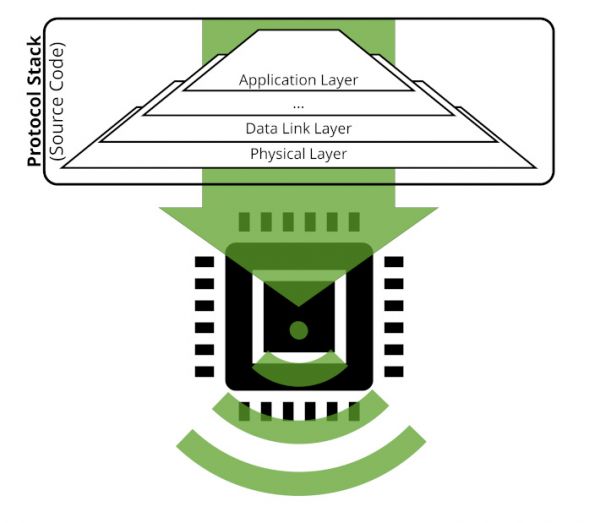Introduction: Digitalization needs Communication
Whether it's smart metering, smart farming, smart industry, smart cities or smart homes – every organization will sooner or later face the challenge of digitalization. Even small companies can benefit from software-driven automation, reducing costs and improving efficiency.
At STACKFORCE, we accelerate the digital transformation across industries and company sizes with our ready-to-use protocol stack software, enabling devices to connect wirelessly and become part of an IoT network.
What Is a Protocol Stack?
A protocol stack is a piece of embedded software that enables devices like sensors or meters to communicate wirelessly. In simple terms, it “teaches” a device how to speak.
The stack is split into multiple layers, each responsible for a specific function – for example, regulating radio access, addressing data packets, or formatting payloads. That’s why it’s called a “stack” – a layered structure of protocols.
Installed invisibly on a device’s microcontroller, the stack uses a radio chip or built-in wireless interface to transmit data – typically via LPWAN technologies such as LoRaWAN® and mioty®, or Wireless M-Bus protocol – to a central IoT platform. This allows real-time or scheduled transmission of relevant information, even across long distances.
Why Are Protocol Stacks Important?
Protocol stacks are essential for automating processes and enabling device-to-device or device-to-cloud communication. Once connected, devices can:
- Collect and transmit data autonomously
- Replace manual readouts and checks
- Trigger alerts or actions automatically
- Support remote monitoring and maintenance
- Enable predictive maintenance and resource optimization
Whether in industrial plants, smart city infrastructure or energy management – stacks provide the communication backbone for efficient and scalable IoT solutions.

Build or Buy? A Strategic Decision
Should companies develop their own protocol stack – or purchase one? While STACKFORCE naturally offers professional software products, the case for buying is strong and objective.
Benefits of prebuilt protocol stacks:
- Ready to use – no years-long development phase
- Proven and robust – field-tested in countless real-world applications
- Cost control – clear licensing models
- Full support – documentation, updates, integration help
- Always up to date – modern communication standards included
- Customizable – tailored features possible
- Shorter time to market – immediate availability
For many businesses, outsourcing stack development saves time, reduces risk, and ensures technological relevance.
STACKFORCE Protocol Stacks – Modular, Reliable, Scalable
As a specialized software provider for embedded communication, STACKFORCE offers a versatile portfolio of standard protocol stacks and multi-stack solutions.
Our key products include:
- OMS® / Wireless M-Bus Stack v4.5.1 for End Devices and Gateways
A long-time favorite – highly modular, scalable, and function-rich. - LoRaWAN® v1.0.4 Stack
Built for demanding environments with maximum security and performance. - mioty® v1.0.0 Stack
Based on innovative telegram splitting for high efficiency and robustness. - Multi-Stacks
Combination of multiple technologies in a single solution – ideal for flexible IoT use cases.
All stacks are platform-independent, easy to integrate, and backed by expert support.
Standard or Custom?
Our standard stacks are perfect for getting started quickly. Off-the-shelf, they can be easily integrated into new or existing devices and systems.
Need something more tailored? We also develop custom solutions, adapted precisely to your project’s requirements – together with your engineering team.
Conclusion: Protocol Stacks Power the Connected World
Protocol stacks are the technical foundation of smart communication. They enable efficient device networking, process automation, and data-driven operations.
With STACKFORCE, you benefit from:
- Fast integration
- Proven quality
- Predictable costs
- Expert support
- Future-proof technologies
Let’s find the right solution for your project – get in touch today!

